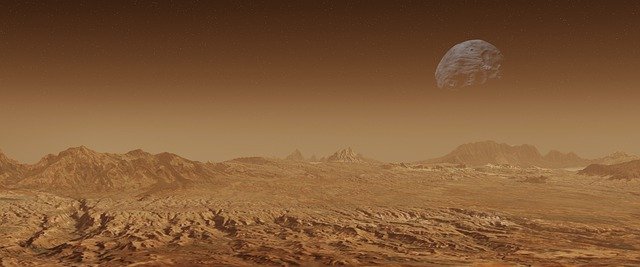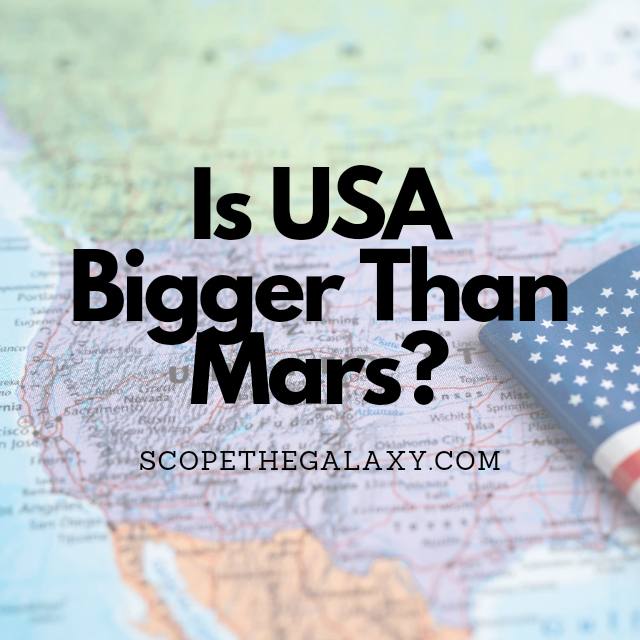*This post may contain affiliate links. This means we may make a commission if you purchase an item using one of our links*
USA may be the 4th largest planet on Earth but, it’s a far cry from Mars’ size despite it being the second smallest planet in our solar system. USA has a surface area of 9.83 million square kilometers and a volume of 393.34 million cubic kilometers while Mars is a spherical entity with a surface area of 144.8 million square kilometers and a volume of 60.8 billion cubic kilometers.
Continue reading if you want a more in depth look at each body along with what makes them as big as they are.
How Big USA?

The United States Of America has a total surface area of 9,833,516 sq. km, which makes it the third largest country in the world. It has a surface twice the area of the European Union’s land, and it is larger than the 107 smallest countries in the world combined.
The largest state in the USA is Alaska, possessing a surface area of 1,070,000 sq km; Texas and California follow at 430,000 sq km and 260,000 sq km, respectively.
These areas represent a flat two-dimensional area, but if we want to compare the size of the USA and Mars, then we need to know the volume.
Earth’s crust ranges from around 5 to 70 km in thickness. Generally, this crust is thicker under the continental land, which averages 40 km. Taking this average and multiplying it by the surface area of the USA, we can calculate that the rough volume of the USA is around 393,340,640 cubic kilometers.
This might sound like a lot, but it still falls short of a variety of other celestial objects where for example the Moon that has 21.9 billion cubic kilometers of volume. Even if we take Earth’s crust at its thickest (70 km), the total volume of the USA is still not comparable to most celestial bodies in outer space.
The actual crust will vary as USA is a diverse country with dramatic variances in terrain. This country’s three most significant mountain ranges are the Appalachians, the Rockies, and the Sierra Nevada which adds altitude to its overall size but, it isn’t so as to make a major difference in the surface or volume of the country as a whole.
How Big Is Mars?

Mars is the fourth planet in line from the Sun and the second smallest planet in our solar system. It has a diameter of 6,779 km, which is only just over half as large as Earth’s (around 53%)
The physical geography of Mars is very different from that of Earth. The atmosphere on Mars is much thinner than ours, and it consists mainly of carbon dioxide (CO2) with small amounts of nitrogen (N2). The surface gravity on Mars is much lower than that on Earth, so an object that weighs 100 pounds on Earth, would weigh just 38 pounds on the red planet.
The surface of Mars is mainly composed of various minerals like iron oxide and silicon dioxide. It also has polar ice caps, but it doesn’t have any oceans or seas.
Olympus Mons is the largest volcano on Mars, with a diameter of 600km. And it is the largest mountain in our solar system, standing at roughly 27km high (almost three times the height of Mount Everest)
The Valles Marineris system of valleys is a vast network of canyons on Mars;the largest canyon in the solar system. It is located in the planet’s southern hemisphere and extends for around 4000 kilometers from east to west; the deepest points can extend up to 10km.
The basic makeup of Earth and Mars is similar as they are both terrestrial planets with a dense metallic core and overlying crust and mantle. However, Earth’s density (5.514g per cubic cm) is higher than Mars’ density (3.93g per cubic cm), suggesting that the red planet’s core contains lighter elements than Earth’s.
The surface area of Mars is around 144.8 million sq. km, about 15 times the surface area of USA. Meanwhile, the volume of Mars is approximately 163 billion cubic kilometers, roughly 410 times that of USA.
Summary
Mars may be a world apart from the largest planets in our solar system but, It’s size advantage over the United States is to be expected as spherical objects will always be larger if all things are equal and even when they aren’t.
In this case Mars has a surface area roughly 15 times that of the United States and a volume 410 times that of the most powerful country on our planet, literally dominating it when it comes to the overall dimensions.

